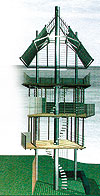By Mike Leidemann
Advertiser Staff Writer
When Hana entrepreneur David Greenberg launched an international competition for tree house designs, he received more than 150 entries from nearly 600 architects in 40 countries. Clearly, the idea of living in a tree still inspires people around the world.
 |
| A German architect submitted this design meant to be built on bamboo stilts and constructed from materials often found along an ocean shore.
Image courtesy treehousesofhawaii.com and arcspace.com |
Forget your ideas of a Swiss Family Robinson paradise. Most of these tree houses are high-tech, low-cost structures. And they’re not homes but hotels, designed for a new breed of tourists looking for an off-beat getaway; jet-age nomads who don’t want to spend their vacation time in another Hyatt or Marriott.
"This proves the fantasy about tree houses remains an international thing," Greenberg said.
Greenberg, who is trained as an architect and urban designer, built his first tree house in a kukui tree on Maui six years ago, using lumber scavenged from the Hana dump. It incorporated bamboo and clear vinyl to create a waterproof, tropical feel.
In the past few years, Greenberg has signed partnership agreements to build tree house resorts in Vietnam, Fiji and China, where he recently completed a Hawaiian-style, off-the-ground hale resort on the tropical island of Hainan. He plans to build 100 new tree houses there this year.
That helps explain why he issued his international appeal for new designs.
"We got sophisticated entries from everywhere," Greenberg said. "Switzerland, Germany, Malaysia, Asia, all over the United States."
 |
| This three-story tree house wrapped around one central pole was designed by Chicago architect Mark Ayes. He calls it The Hale. Nearly 600 architects from 40 countries entered the international competition for tree house designs. Many architects took advantage of advances in materials and computer images in designing their structures.
Image courtesy treehousesofhawaii.com and arcspace.com |
The competition required designs to be 10 to 45 feet high and have no structural contact with the ground, except for a ladder. Roofs and walls were optional, but a toilet, shower and cooking areas were required, although some of these facilities could be on the ground. The floor areas were to be between 500 and 1,000 square feet with room to accommodate from two to six people.
Few of the entry designs resemble a house you would build for kids in the backyard. Instead, many took advantage of advances in materials, designs and computer imaging to come up with projects out of the Jetsons or "The Matrix."
Others took a more indigenous route, with designs reminiscent of a coconut, a thatched hut or wicker fishing basket. There was even a tree house in a suitcase design for those who want to take their own leaf-level lodgings along with them.
Many of the entries came with a bit of philosophy, too.
"A tree house explores the realm of another place, a place not quite like home, yet not quite unlike the world we know," one architect wrote. "This place is, in fact, suspended between the necessities of life and a flight of fancy."
Somebody else wrote: "A tree house is neither a tree nor a house. It establishes a symbiotic relationship between the tree and a house. Our intervention is interwoven within the tree. Its movement allows this relationship to fluctuate, blurring the edges."
Many of the entries were designed for palm trees.
"Palms are good for tree houses, as long as you keep the structures close to the ground where they don’t blow around too much," Greenberg said.
 |
| Tree houses have the power to inspire tropical fantasies. “A tree house is neither neither a tree nor a house. It establishes a symbiotic relationship between the tree and a house,” one architect wrote when submitting a design.
Image courtesy treehousesofhawaii.com and arcspace.com |
Estimated costs of the projects ranged from $1,000 to $100,000.
A jury of artists, architects and others selected 100 winning designs. As many as 10 of the most practical designs could end up being built in Hainan, where Greenberg’s contract calls for him to build the tree houses on a resort in Nanshan Cultural Park, a 5,000-acre, $800 million Buddhist amusement park.
Winning architects will be paid for their designs and allowed to stay in the tree-house resort free for one month.
Greenberg, 58, fell in love with Hawai‘i in 1969 and bought property in Hana in 1975. Although he has studied, practiced and taught architecture in California, he now lives in Hana but is not licensed here.
He has, however, designed and built in Hana three tree houses, which he uses as vacation rentals. Even though they don’t meet all county building standards, officials turn a blind eye to their shortcomings, he said. (The tree houses rent from $69 to $89 a day; they can be viewed on a company Web site: www.treehousesofhawaii.com)
"As I understand it, anybody can build and occupy their own tree house as long as the structure doesn’t touch the ground," he said. "You don’t need a permit for that, but you can’t build a tree house and rent it out."
Greenberg said he’s working with officials in Maui to come up with designs that meet all the legal requirements.
"I’m hoping to inspire other people to come up with their own solutions."
[back to top] |

 The Great Index to Fun
The Great Index to Fun

